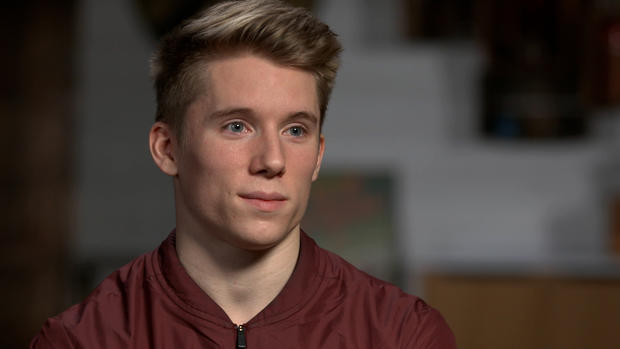Some colleges axing "secondary sports" like gymnastics and tennis as pandemic continues
American universities have been rocked by the coronavirus pandemic. Some have shut their campuses down completely. But schools that play big-time sports have gone to remarkable lengths to save their football and basketball seasons.
Some colleges are testing every player and coach for the virus every day and even that hasn't stopped outbreaks; many games have had to be canceled or rescheduled. But still, they press on.
They do it, of course, to keep the TV money coming in from football and basketball. But at the same time, dozens of universities have been eliminating smaller "secondary" sports like gymnastics and tennis and swimming. Those sports are getting the axe because they don't generate much revenue, but the dreams of the athletes are no less real.
Mike Burns: It was kind of a surgical strike, if you will, you know? A 15-minute call to-- to tell 'em that, "Your life as you know it is now changed forever."
Mike Burns is the men's gymnastics coach at the University of Minnesota. On September 10, he and the 18 student athletes on his team were about to start practice when their phones all began to buzz.
Mike Burns: We had a text message at about 1:20 p.m. And it said, "You need to be on a Zoom call at 2:00 p.m."
On that call, Minnesota athletic director Mark Coyle told them that the men's gymnastics program would be eliminated, along with men's tennis and men's track and field.
Coyle said the covid pandemic had blown a multi-million dollar hole in the university's athletic budget. He said they were cutting salaries and costs wherever possible, but that cutting entire sports was necessary too.
Shane Wiskus: I do not regret coming to the University of Minnesota one bit. But I'm still mad.
Senior Shane Wiskus is the star gymnast on Minnesota's team, which two years ago finished second overall at the NCAA Championships.
Shane Wiskus: I think the team that we have right now is arguably one of the most talented teams we've ever had. So to see that a lotta these guys are gonna have to be done with the sport, it breaks my heart.
Bill Whitaker: I mean, just looking at it from the outside, it almost seems like you're on that high bar and when you do one of your dramatic releases, they pull the high bar away.
Shane Wiskus: That's exactly how it felt at first, I can tell you that much.
When Shane's coach Mike Burns was competing as a college gymnast at Penn State back in the 1970s, more than 150 universities had men's gymnastics programs. By the beginning of 2020, that number was down to 15. Now, with Iowa and Minnesota axing their teams, it's down to 13 and Mike Burns is out of a job.
Bill Whitaker: Do you think the athletic director was looking to get rid of the gymnastics program and is sort of using the COVID-19 pandemic as, as an excuse?
Mike Burns: I think every athletic director who's dropping programs is using the COVID pandemic as an excuse. There's financial issues everywhere, I get it. But-- I-- I feel like athletic directors have a manual on their top shelf. Athletic Director's Manual, let's pull it out. Oh, financial struggles. Solution 1: Cut programs. Psh. Put it back up: "We're gonna cut some programs."
And cut they have. This year at least 30 universities have cut almost 100 programs; soccer, squash, golf, gymnastics. Football powerhouse Clemson cut men's track and field, Stanford eliminated 11 sports. Schools are honoring existing scholarships, but more than 1,500 student-athletes, both men and women, will no longer have a team to compete for.
Victoria Jackson: You have a budget crisis and so you've gotta trim it in some way, and so you strip opportunities from both sides. There are other ways to trim the budget.
Victoria Jackson won an NCAA championship in the 10,000 meters while running for Arizona State University. She's still running, and is now on the faculty at ASU, where she specializes in the history of college sports, including the history of secondary sports getting the axe.
Bill Whitaker: During the Great Recession after 2008, colleges and universities responded the same way. And they cut these non-revenue-generating sports. The-- this is a pattern.
Victoria Jackson: That's right. Every time there's an economic downturn you protect the core business, which is football, which means that other sports are on the chopping block.
Minnesota and the Big Ten Conference where its teams play provide a perfect illustration. Even as three Big Ten schools eliminated a total of nine non-revenue sports, the conference moved heaven and earth to get football players back on the field – and back on the air, in order to preserve TV revenue.
Victoria Jackson: Higher education is operating a professional football league. But then the athletes, the labor, the players who are playing football, are considered to be amateur. If you can't offer high school recruits a salary, you spend money in different ways. So you get the best coaches. And those coaches enjoy-- increasing salaries. You build the best facilities. We've seen a facilities arms race.
Bill Whitaker: You call it an arms race. What-- what do you mean by that?
Victoria Jackson: I mean that if Alabama builds, I mean a unbelievable locker room facility, Now every other school that's competing with Alabama for recruits has to build something like that to showcase to recruits.
Minnesota's own palatial locker room is in the shape of a football. Its football coach, P.J. Fleck, has taken a pay cut to help cope with the COVID crisis, but he'll still make more than $4 million this year. Schools will spend almost any amount to build winning football and basketball programs, so even in good financial times, their athletic budgets are more like the federal government's: deficit spending has become the norm.
Bill Whitaker: I have read that the median annual deficit among the 130 top colleges, schools, was $14 million. And that was before the pandemic.
Victoria Jackson: I think the schools might consider that to be successful. That's a small shortfall. 'Cause the goal is to spend it all. So-- I think they would consider that to be-- (CHUCKLE) to be a good job.
Bill Whitaker: $14 million loss or deficit is just the cost of doing business?
Victoria Jackson: Oh, absolutely.
The NCAA Basketball Tournament was cancelled this past spring due to the pandemic. In normal times, CBS and Turner together pay the NCAA nearly a billion dollars a year to televise March Madness. By contrast, eliminating men's gymnastics, tennis, and indoor track and field will save the University of Minnesota a total of $1.6 million dollars.
Bill Whitaker: Does cutting your program get anywhere close to balan-- balancing the budget?
Mike Burns: If it does, I'd like to see those numbers. I know I don't-- I'm not the head of the math department, but that doesn't make sense to me.
Minnesota insists that financial pressure isn't the only reason sports are being dropped; it also cites Title IX, the federal law that requires schools to match the gender makeup of their student bodies in their sports teams. So if 54% of students are women, 54% of athletes should be too. To get to that balance, schools often choose to cut men's sports rather than create new ones for women.
Victoria Jackson: Title IX is often the scapegoat when universities cut teams. Again, it's to protect the core business, which is football, but you can kind of use this gender justice shield to-- kind of throw men's non-revenue sports under the bus.
Football is often what gets universities in trouble with Title IX in the first place. Minnesota has 115 men on its football roster, which means it needs 115 female athletes just to balance that single sport.
Shane Wiskus: You kinda know that football's the top dog and all the revenue sports are the top dog. But this is just a very clear, backhanded-- decision that, you know, it hurts.
Shane Wiskus has a very real shot at making Team USA for next summer's Olympic games in Tokyo. But he worries that younger teammates now won't be able to pursue their olympic dreams.
Bill Whitaker: How important is being part of a college team? How important is that in-- in helping you pursue that dream of reaching the Olympics?
Shane Wiskus: NCAA Gymnastics I believe is a crucial component in preparing gymnasts for, you know, not only success for their team, but success for the United States on the world and Olympic podiums.
Sarah Wilhelmi: At its core, it is truly how we train our young people. And that is an asset we can't lose.
Sarah Wilhelmi ran track for the University of Iowa. Now she's in charge of college partnerships for the U.S. Olympic Committee.
Bill Whitaker: Do you think that most Americans understand how big a role colleges and universities play in producing our Olympians?
Sarah Wilhelmi: 85% of our 2016 team, our medalists were college athletes. We did a case study with USA Swimming. And we looked over a ten-year period to see what our footprint was. There were 370 athletes that were on Team USA in that ten-year period for swimming. 366 competed in college.
And because American colleges recruit many foreign athletes, it's not just Team USA that benefits.
Sarah Wilhelmi: Well, we did some homework in Rio with the NCAA and there were over 600 international athletes from over 100 different countries that were competing in the NCAA and then went to Rio to represent their country as well.
But the extraordinary Olympic pipeline is now under strain, as more and more sports get the axe.
Sarah Wilhelmi: These athletes work their whole life to represent their school. It's a dream. And for them to lose the opportunity is-- it is devastating to them. And-- and what I'm so impressed with, those athletes, but also those coaches quickly turning to action. What can we do to keep our sport intact?
In the days after their program was canceled, Mike Burns and his team did come up with a plan to make their sport pay for itself, by developing a money-making youth gymnastics club.
Mike Burns: You know, we put together a, a-- kind of a business model, if you will-- to create a self-sustaining gymnastics program.
Bill Whitaker: And Athletic Director Mark Coyle: He, he didn't give you a chance to try to save the program, try to find other sources of funding?
Mike Burns: Nope.
Mark Coyle did not agree to be interviewed for our story. Instead, he sent us a statement: "the University of Minnesota believes that the changes it has made, however heartbreaking, will best position its department of athletics for sustainable, long-term success."
Bill Whitaker: In college sports, football does pay all the bills, doesn't it?
Shane Wiskus: It does. Yup. Don't get me wrong. I-- I respect the football team and what P.J. Fleck has done for them. But their hard work is not any more important than our hard work
Mike Burns: So I kinda had this image of the-- the seven athletic directors in the Big Ten that have men's gymnastics. And they're sittin' around the poker table with their visors down and their stogies and their glass of whiskey over here, and they go, "Okay, I'm gonna-- I'm gonna call your men's gymnastics and raise your men's tennis." "Oh, that's a good bet! I'll call you men's tennis: What do you got?" And, like, using us as-- as poker chips in a way, you know? And-- but it's more than just a poker chip. It's somebody's life, you know?
The University of Minnesota cancelled its football game this weekend after more than 45 players and staff tested positive for COVID-19.
Produced by Rome Hartman. Associate producer, Sara Kuzmarov. Broadcast associate, Emilio Almonte. Edited by Richard Buddenhagen.








